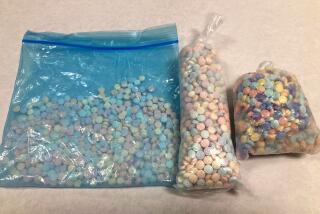A baby is born addicted to drugs about once an hour, study says
Hereâs some depressing news to kick off your week: The proportion of pregnant women who are addicted to opiates increased nearly fivefold between 2000 and 2009. Accordingly, the proportion of babies born addicted to the drugs who experience withdrawal after birth nearly tripled during the same period.
These calculations come courtesy of researchers from the University of Michigan and the University of Pittsburgh, who reported their findings in a study published online Monday by the Journal of the American Medical Assn. After combing through hospital data compiled by the federal Agency for Healthcare Research and Quality, the team found that 3.39 out of every 1,000 babies born in an American hospital in 2009 had neonatal abstinence syndrome, up from 1.2 out of every 1,000 hospital births in 2000. That translates to 13,539 newborns in 2009 â or roughly one born per hour that year.
Neonatal abstinence syndrome, or NAS, affects babies who become addicted to drugs in utero -- especially opiates -- and go through withdrawal once they are living outside the womb. Symptoms include seizures and tremors, respiratory distress, vomiting and an inability to eat without becoming sick.
Treatments havenât improved much in the past decade, and some babies require morphine or methadone to get over their addictions. The typical baby born with NAS winds up staying in the hospital for about 16 days before he or she can be discharged, according to the JAMA report.
The immediate cause for this spike in babies with NAS is an even larger spike in pregnant women addicted to prescription painkillers, heroin and other opiates. According to the federal data, 5.63 out of every 1,000 mothers who gave birth in a hospital in 2009 were addicted to opiates, up from 1.20 per 1,000 in 2000, the study found. Experts estimate that 60% to 80% of babies exposed to heroin or methadone in utero wind up addicted themselves.
The average cost of caring for a baby with NAS has risen from $39,400 in 2000 to $53,400 in 2009 â an increase of 35%, despite the fact that the amount of time affected infants remained in the hospital didnât change over the decade. Adjusting for inflation, the total money spent to care for babies with neonatal abstinance syndrome jumped from $190 million to $720 million over that period. The share of the total tab picked up by Medicaid rose from 69% in 2000 to 78% in 2009, according to the JAMA study.
In an editorial that accompanies the study, two experts from Maine (which has one of the highest rates of addiction to prescription opiates) bemoan the fact that treatment for infants with NAS and their addicted mothers has improved so little in recent years.
âNovel pharmacotherapy research is needed to improve maternal opiate maintenance strategies to protect the fetus from in utero withdrawal, and to reduce the incidence and severity of NAS,â they write. As one hopeful sign, they mention recent findings that link two particular genes with the severity of withdrawal symptoms in newborns. Someday, doctors may be able to tailor their treatments for these babies by checking to see what versions of these (and perhaps other) genes they have.
You can read the study here and the editorial here.
Return to the Booster Shots blog.







